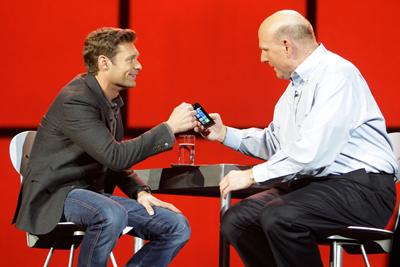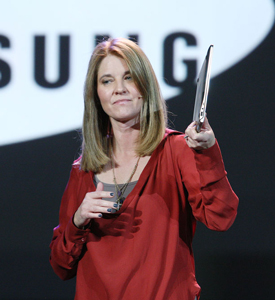News
CES: Ballmer Keynote Spotlights Kinect, Windows 8 and Windows Phone
- By Kurt Mackie
- January 10, 2012
With this reportedly being the last Consumer Electronics Show to feature Microsoft as a headliner, Microsoft CEO Steve Ballmer's opening-day keynote should have been a shining moment.
But on Monday night, it was
"Sesame Street"'s Cookie Monster that stole the show.
The keynote talk mostly featured Ballmer in a dialog with "American Idol" presenter and disc jockey
Ryan Seacrest. Also taking the stage at the Las Vegas event happening this
week was Tami Reller, Windows chief marketing officer, who talked about
some Windows 8 basics. Two product managers also discussed Microsoft's
Metro-style user interface used in Windows Phone 7 and Windows 8. The
Metro UI is seen by Microsoft as the central unifying experience across
applications, videos, games, music and social networking.
Tickle Me Xbox
Much of the keynote covered old ground for Microsoft, so it was perhaps an
unintended consequence that "Sesame Street"'s efforts grabbed the limelight.
It turns out that "Sesame Street" is using Microsoft Kinect, the sensor
add-on to Microsoft's Xbox gaming console, to make its recorded videos for
children interactive with viewers. A cutaway video during the keynote talk
showed "Sesame Street" character Elmo counting coconuts thrown by the viewer
toward the screen. The magic number was "4" coconuts to catch, and Elmo
verified the count.
Prior to the "Sesame Street" bit, Ballmer, the luminary of the keynote,
added some impressive numbers of his own. He said that Microsoft has
shipped more than 18 million Kinect sensors over the last year. Ballmer
added that there are more than 66 million Xbox console users and more than
40 million Xbox Live users. Toward the end of the presentation, Ballmer
noted that Microsoft is just getting started with interactive TV and
Kinect. He suggested that Kinect would revolutionize other industries in
the near future, such as health care.
Comcast will soon be launching on Xbox Live. Microsoft also has
established a partnership with News Corp. that will bring the Fox TV
network and The Wall Street Journal to Xbox Live sometime this
year. In addition, Microsoft has Xbox Live content deals in place with
AT&T's U-verse, Telus and Telephónica.
Microsoft will be bringing Kinect to Windows, which Ballmer said would arrive in "just a couple of weeks." (See: "Kinect for Windows Coming Feb. 1.")
Windows Phone 7 and Windows 8
Windows Phone 7 constituted much of the "news" during the keynote, with Nokia's
Lumia and HTC's products featured, specifically the HTC
Titan
II. The Nokia Lumia 710 and Lumia 800 will be coming, Ballmer said.
The Lumia 710 can be bought in the United States now, but the Lumia 800
will be available in "the next few months." The Nokia Lumia 900 was
unveiled at the show. It features a 4.3-inch screen and will be available in "the next few months," Ballmer said. (See also: "Nokia's New Windows Phone Has a Front-Facing Camera.")

|
| Microsoft CEO Steve Ballmer (right) shows Ryan Seacrest the latest Windows Phone, the Nokia Lumia 900. (Source: Microsoft) |
AT&T will be the mobile carrier selling Nokia's new phones in the
U.S. markets in first half of this year. The Lumia 900 and the HTC Titan
II will be supported with "4G speeds delivered by LTE or HSPA+" on
AT&T's wireless network, with 4G speeds available in some markets.
Important Windows 8 news had already been described by Microsoft before
the CES 2012 keynote. For instance, Windows 8's next milestone (a beta
release) will happen in "late February," something that Microsoft had announced
in
December.
Next page >>
Coinciding with the Windows 8 beta, Microsoft plans to open its online
Windows Store for Metro-style applications in late February. The online
store will be available in more than 100 languages. Both free and paid
apps will be available in more than 200 regions, according to Reller. She
claimed that developers will be able to write once and have their apps run
across both platforms (x86 and ARM). Presumably, this capability is only
true of Metro-style apps based on HTML 5, XAML or JavaScript, but Reller
didn't get into those specifics.
A tablet running AMD's ARM-based Tegra 3 chip and Windows 8 was
spotted
at CES 2012. However, this keynote didn't feature very much
discussion about Microsoft's Windows 8 ARM strategy, which had
been
a major topic at Ballmer's CES 2011 keynote. Similarly, there was no
talk during the keynote about Intel and AMD's progress in building
system-on-chip processors for Windows 8.
Reller mentioned just a few pieces of hardware on stage, without
describing it or the OS used. She named the HP Envy 14 Spectra Ultrabook
and the Samsung Series 9 notebook (less than 13-mm thick, 2.5 lbs, 15-inch
screen). She also said that Dell plans to announce a new ultrabook at CES.

|
| Microsoft’s Tami Reller, chief marketing officer, Windows and Windows Live, shows of the Samsung Series 9 PC, which is less than 13 millimeters thick and weighs just over 2-1/2 pounds. (Source: Microsoft) |
Intel represents the big push behind "Ultrabooks" (an Intel brand name).
Ultrabooks are thin and lightweight notebooks with relatively fast boot
times and good battery lifespans, according by Roger L. Kay, founder of
market research firm Endpoint Technologies Associates, in a January Forbes
article. Kay noted that Ultrabooks meet his criteria for enabling
high mobility for users, thereby falling into the same marketplace
category with smartphones and tablets.
Metro Magic
Ballmer ended the keynote by saying that Windows 8's Metro-style user
interface would be everywhere -- across PCs, tablets, TVs and phones. He
claimed that Metro, which features a squarish tile-like user interface,
will will drive "a new magic that will make one plus one equal three."
All in all, it was a lackluster CES 2012 keynote address, which
purportedly was Microsoft's
last
keynote talk at the device-centric event. Apple already stays away
from the event and Microsoft seems to be following suit. However, Gary
Shapiro, president and CEO of the Consumer Electronics Association,
characterized Microsoft's decision to stay away as "a pause." In his
opening remarks, Shapiro recounted Bill Gates many past appearances at CES
stemming back to 1995. Microsoft will take a break in 2013, Shapiro said,
but "I would be shocked if a Microsoft leader didn't return to this stage
in a few years," he added.
More from CES 2012: